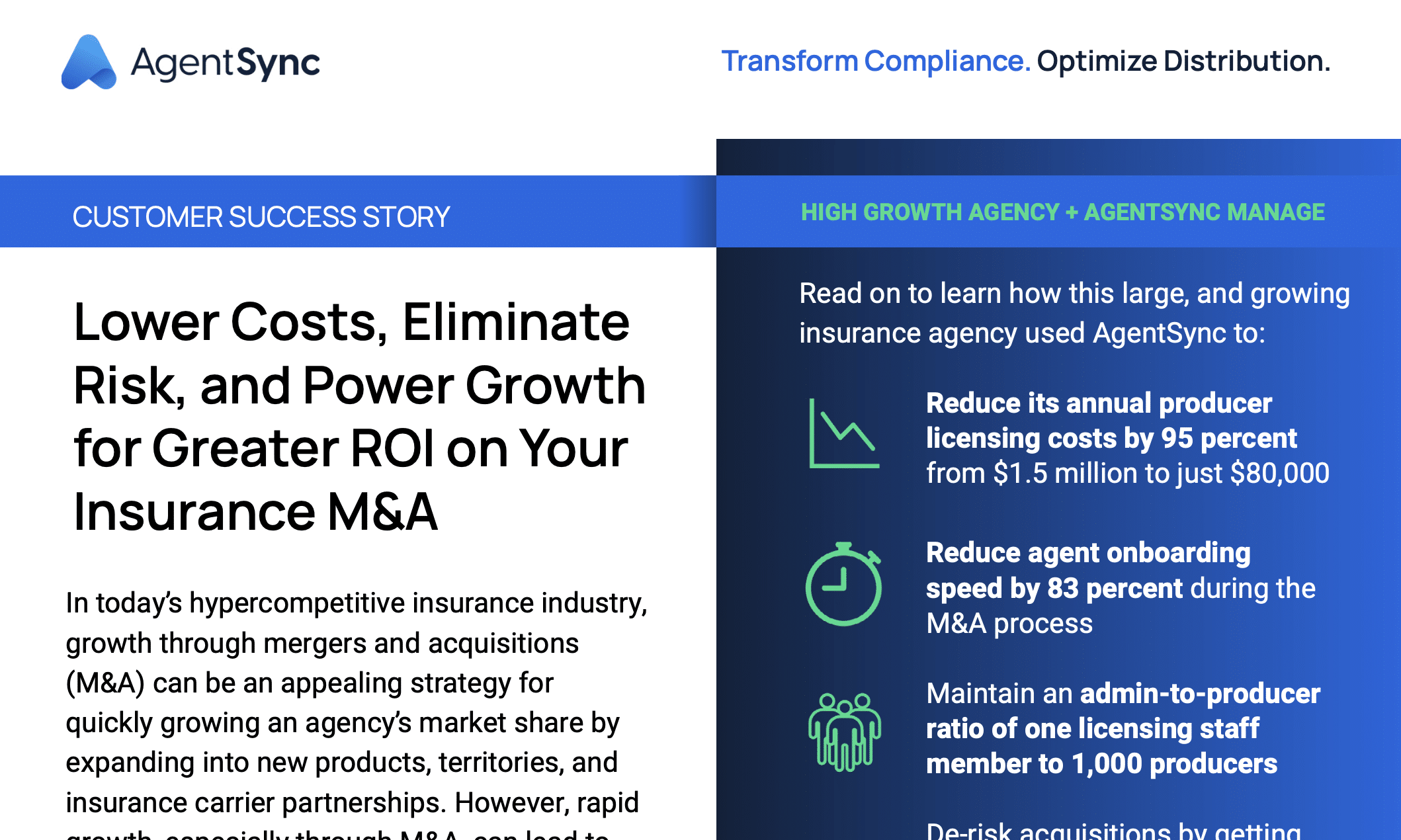

For high-growth insurance agencies and carriers, acquisitions are a core part of business expansion. Yet, if you don’t keep your acquisition strategy streamlined and efficient, you end up with an upside-down revenue model.
The best way to control your costs and achieve your target profit margin is to centralize the core functions of your acquisitions. This doesn’t mean all your producers have to wear the same logo—for some businesses, it will always make the most sense for each downstream business unit to maintain its own culture, flavor, or “local” feel. But, even if the branding and offices remain separate, compliance and distribution channel management services are something you should centralize, full stop.
5 risks of decentralized compliance and distribution partner management strategy
If you don’t centralize some core functions of your business and all of your subsidiaries (like, cough cough, compliance and producer management), you handcuff the benefits of your acquisitions. Sure, new acquisitions will bring in profit potential, but, if there’s no efficiency gains, then that relationship will coast along on a set schedule of earnouts and it’ll take years for you to actually see the return on your initial investment.
If you’re not centralizing your compliance and distribution partner management, specifically, you face five key risks:
Risk No. 1: Business disruption and change management risk
Each acquisition is a fire drill of paperwork—some of that is unavoidable. But, if producer licensing, appointment, and compliance functions all remain at the local business level, your downstream producers get the feeling that “this is the new boss, same as the old boss.” The experience can feel pointless and cause disruption to your selling agents with little payoff or gain to them, and the risk that they will churn or that the information transfer will introduce new errors for you. This danger of churn, or of slowing down your processes as you onboard your new producers also presents a very real danger to your bottom line: Slowing down to onboard producers risks the profit of the business they could be writing in the meantime.
Risk No. 2: Regulatory risk
If you don’t own the compliance and producer management functions of your business, you take on the risks of each business unit handling this in different, often fractional ways, where compliance and license validation is only a portion of someone’s responsibility. This can lead to sales under lapsed licenses, inappropriate and unlicensed commissions payouts, and wasted fees for late license renewals. Further, if compliance is a distributed, fractional responsibility, you likely face the risk that whoever manages this function lacks the kind of institutional knowledge critical to protecting the producers under their purview. Each of these scenarios carries its own regulatory risk, and regulatory risk can easily spiral into reputational risk.
Risk No. 3: Very little transparency
How many agents write business for your insurance carrier or agency? How much does each insurance producer cost you? What’s the true ROI on each producer or even each business unit? When the costs of licensing or appointing are opaque, when you can’t connect costs with earnouts, or when you can’t tell how much of a business unit’s commissions are paid based on a single individual national producer number, then you don’t have adequate transparency to evaluate your costs, your risks, or your business health.
Risk No. 4: Decreased perceived value for new acquisition
Part of the business risk is the perceived value you bring to your acquired distributors and their individual producers. When you provide centralized services that take difficult or boring tasks off of your partners’ plates, you can drive home the value that your relationship presents. This is something that must be done well, or you risk the perception that you’re “too big” for your new acquisition, and that you can’t actually provide the services you say you can.
Risk No. 5: Limited size of acquisition
If you can’t handle the change management, centralize the core functions of your acquisitions, and crank up your efficiency, then you’re going to lock your growth to only being able to acquire agencies or carriers of a certain size. Otherwise, the sheer size of your acquisition’s producer force would overwhelm your infrastructure. For businesses that allow their agencies to handle producer management and compliance duties as one-off, distributed services, the producer-to-administrator ratio tends to be very high, meaning more of your headcount is dedicated to these duties than you likely realize.
Why AgentSync is the partner of choice for high-acquisition insurance agencies and carriers
AgentSync is purpose-built for insurance, leading prominent carriers and agencies across the spectrum to use our contextualized data and core software as part of their modernized infrastructure.
For insurance carriers and agencies that are growing primarily through aggressive acquisition strategies, AgentSync presents a particular value, with customers leveraging the following features:
- Automated workflows: Automated workflows take tedious, predictable, and highly manual tasks off your team so your human team can use their big beautiful brains for high-leverage work and more white-glove services.
- API-driven, vendor-agnostic integrations: By breaking down silos, our standardized data makes it easy to integrate data up and down your tech stack so the people who need to make data-based decisions have the information they need when and where they need it. Integrate with a background check provider and streamline onboarding. Integrate with a commissions system and make sure every commission is paid out on time and in compliance. The possibilities are endless.
- Hierarchy Management: When your partnerships change, producers move, or leadership structures split, you can reflect that change instantly across all your systems. Stop repetitive data entry by ensuring your data is right the first time and every time in your source-of-truth software.
- Scorecard: Is your sales territory stacked with agents who are actually ready to sell? Know at a glance where you’re ready and where you should focus your operational efforts.
- Reporting: It’s not just about who is licensed and where. With the most robust out-of-the-box reporting, you can report on who’s appointed in what territories to see gaps and opportunities in your distribution strategy.
- Bulk actions: Need to expand into Montana? You could go agent-by-agent for appointments or license applications. Or you could submit records in bulk. Montana, check. Who’s next?
If you’re not sure a tech upgrade can transform your producer-to-admin ratio, keep reading and let us convince you. If you’re ready to see what, specifically, AgentSync can do for you, schedule a customized demo.

